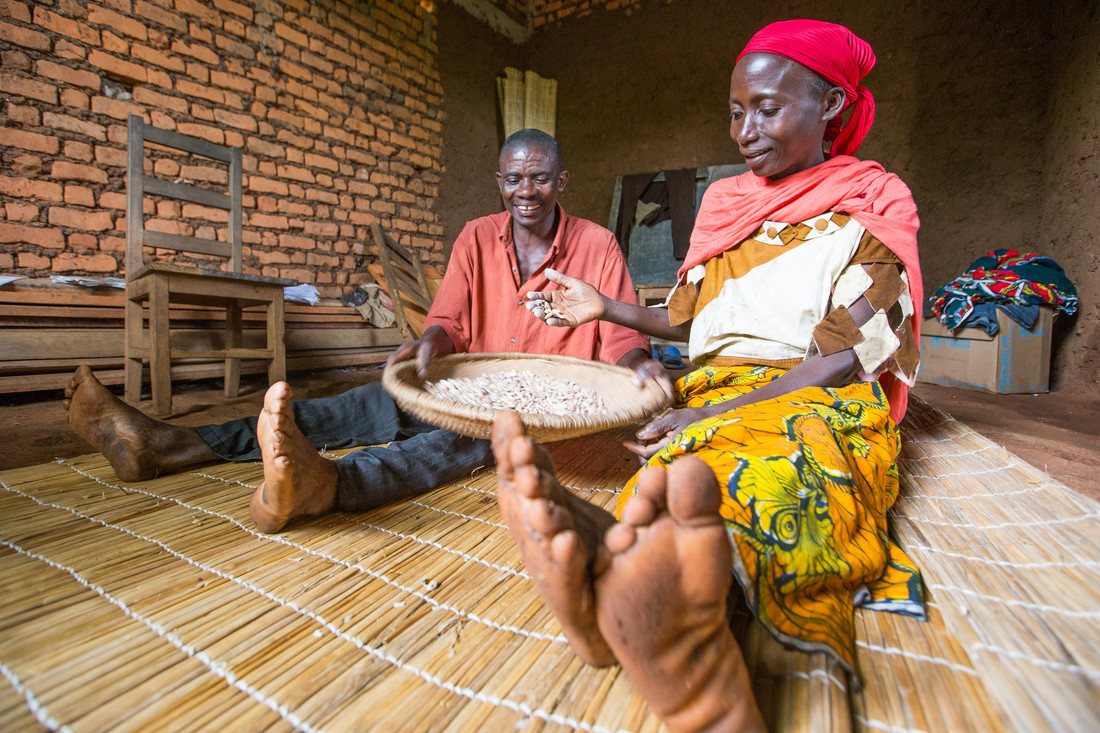
For Calinie and Theophile, like for many other Burundians living in rural communities, living from their land was almost impossible until recently. Limited agricultural knowledge, extreme paucity of arable land and high levels of soil erosion meant crop failures were a fact of life, while disease took its toll on prized cows and goats.
As a consequence, sporadic income from crops (beans, peanuts, cassava and maize) meant the family struggled to make ends meet, put enough food on the table and pay regular medical bills. These periods of food insecurity left their mark on their four children, now aged six to 22 years. “We often didn’t have enough food for three meals a day, the kids would sometimes go to school on an empty stomach,” said Theophile.
Holding a drawing, Theophile said: “Before our farm looked like this, we grew crops in the traditional way. We thought this was normal, but now with the changes, we do much better.”
From traditional small-scale farmers to sustainable entrepreneurs
The changes Theophile is referring to transformed his family's lives completely two years ago when Oxfam implemented an innovative farming approach as part of the four-year‘Support to Agricultural Productivity in Burundi’ (PAPAB) project across six provinces. One of the key features that made this new approach so remarkable is that it converts traditional small-scale farmers into sustainable entrepreneurs, who also help preserve and maintain their village's natural resources through taking responsibility and working together in the shared interest of a better future.
For Calinie and Theophile and 30 other families from their village, this farmer-to-farmer approach starts with each family producing two drawings that visualize their current farming situation and the family’s desired future. “They told us to go home, draw what we see and then draw how we want our future to look. They taught us as husband and wife, to ensure we understand the project and our objectives,” said Calinie. With a vision of the future committed to paper, Oxfam analyses what interventions are needed at home and what skills and assets will have to provide to bring it to life.
 Line planting technique in place.
Line planting technique in place.
A series of training follows on integrated agricultural techniques (crop production, land management, livestock rearing and income-generation activities) so each family has the knowledge and tools to cultivate a better future. Moreover, the project team and agronomists visit the different families to ensure technical aspects of interventions are addressed.
“Before we didn’t know how to plant and care for our livestock. Now we have this knowledge and can work towards our vision,” said Theophile.
Calinie said the drawings were particularly illustrative of progress made and served as motivational tools. “These maps and drawings we created are like a timetable and calendar. When we look at them we see how far we have come, we know we can’t go back to the way we lived before,” she said.
With this innovative Integrated Farm Planning (PIP) approach taking root to deliver results, Calinie and Theophile’s family is stepping forward to a better future.
 After a long morning in the fields, Calinie and Theophile pick through their bean harvest before heading to market in Kanyosha, a small agriculture-dependent commune in western Bujumbura province. Increased sales since the adoption of the PIP approach have resulted in money to start renovating the small home.
After a long morning in the fields, Calinie and Theophile pick through their bean harvest before heading to market in Kanyosha, a small agriculture-dependent commune in western Bujumbura province. Increased sales since the adoption of the PIP approach have resulted in money to start renovating the small home.
Integrated agricultural techniques – such as line planting, effective seed selection and drainage – have resulted in higher yields and incomes. “In just two years, our bean harvest has jumped five-fold to 250 kg. So now, we can sell our surplus. There is now money for school fees, clothes for our children, medicine, we can buy livestock and even hire people to work the land,” said Theophile.
As enshrined in the PIP approach, the couple is now empowered to inspire others in the village to adopt sustainable farming practices and scale-up the project.
“Even when my husband is away, I gather people and teach them. I’m proud they listen to me. We’ve trained about 100 people,” said Calinie.
This PIP-inspired community empowerment has also translated into collective action with Theophile leading the way in encouraging families to support a village tomato crop with 2,300 plants. “Our idea and vision for the future is to form a cooperative. This is a dream we have,” said Calinie.
Two years after Oxfam’s PIP approach planted the seed and changed the mind-sets of Calinie and Theophile, they are determined that resilient and sustainable farming systems will continue to blossom in Kanyosha and other rural communes in Burundi. “Before we were dependent on outside help, now we can produce enough for ourselves. Today, I don’t need an agronomist and next year we will grow more crops,” said Theophile.
Join us and get involved
Do you want to know more about our work and learn how you can help? Sign up for our newsletter and we will keep you informed of our campaigns, projects and humanitarian work via email.